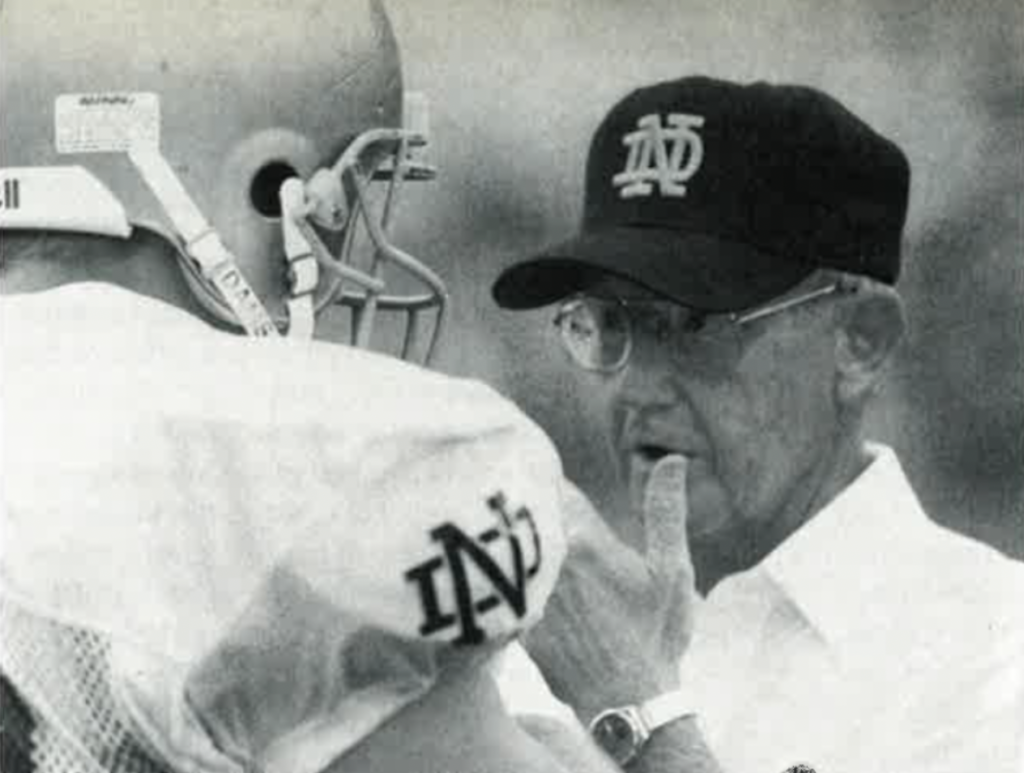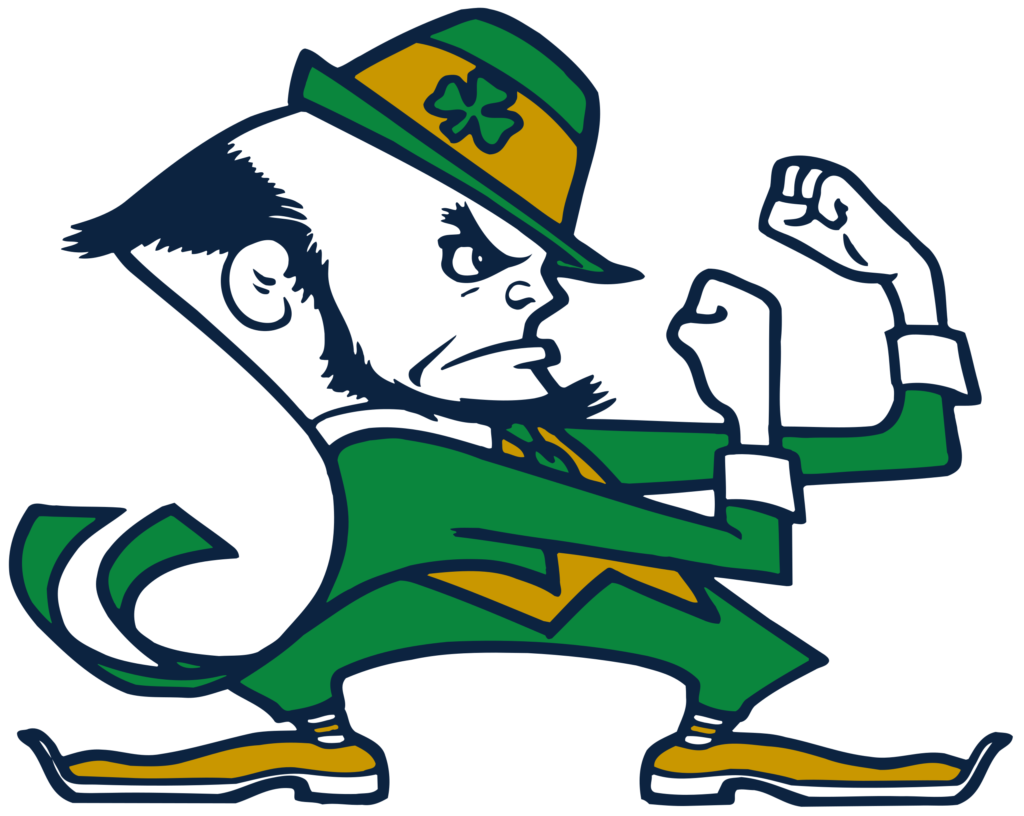This exchange in a novel about college sports in the 1920s catches the prejudices that many Americans of the time held toward citizens of Irish-Catholic descent. However, unlike other immigrant groups who tried to submerge their ethnicity into the American melting pot and considered such terms as “Polack” and “Bohunk” insults, Irish Catholics gloried in many of their nicknames, particularly the one given to the Notre Dame football team: the “Fighting Irish.”
Like other traditions at the school, the origins of the Notre Dame nickname are both obvious and obscure. As previously noted, the many Irish boxers and champions in the popular nineteenth-century sport of prizefighting, coupled with N.D.’s preponderance of students, faculty, and administrators of Irish-Catholic descent, is the most probable source. But the first use of the term is not definite.
One history of Notre Dame football quotes an old alumnus remembering the Northwestern students yelling “Kill those Fighting Irish” during the 1889 game. Other histories claim that halfback Pete Vaughan, during halftime of the 1909 struggle with Michigan, looked around at his mainly Irish-American teammates and spit out, “What’s the matter with you guys. You’re all Irish and you’re not fighting!” Both tales, however, depend on the memory of the teller and, if accepted, reflect glory on that person.
More authentic than these questionable anecdotes are the early uses of the term in the press: the 1904 Scholastic mentions that in the loss at Wisconsin, “the plucky fight of our boys won the applause of the crowd, who rooted for the ‘game Irishmen’ all during [the contest]”; in its coverage of the 1909 victory over Michigan, the Detroit Free Press reported: “Eleven fighting Irishmen wrecked the Yost machine this afternoon. These sons of Erin individually and collectively representing the University of Notre Dame …”; and by 1914, The Dome lauded the “traditional Irish fight of the Notre Dame” players and students.
During the first decades of N.D. football history, however, the midwestern press usually called the team the “Catholics,” or, if strongly anti-Notre Dame, “Papists,” “Horrible Hibernians,” “Dumb Micks,” and “Dirty Irish” — fans of opposing squads often yelled the last two insults. N.D. student publications carefully avoided these terms and usually referred to their players as the “Gold and Blue,” the “Notre Damers,” “Warriors,” and occasionally, the “Irish.”
From 1913 on, because of the team’s annual trips east and its other travels, Chicago journalists began tagging them the “Ramblers” and the “Nomads.” The New York newspapers, however, preferred “Hoosiers,” and in the early 1920s, the New York Daily News tried “Hoosier Harps” (considering its Irish working-class readership, no insult was intended).
Like everyone living in Indiana, Rockne was frequently asked about the origin of the word Hoosier. He usually replied with an anecdote that also illustrated the toughness of Notre Dame football: “After every game the [N.D.] coach goes over the field, picks up what he finds, and asks his team, ‘Whose ear is this?’ Hence Hoosier.”
For many years, Notre Dame administrators disapproved of the “Catholic” and “Irish” nicknames. President Burns wrote that the terms are discountenanced by the authorities of the University “but because often their usage is in a playful spirit, no offense being intended, this makes it the harder to deal with the matter effectively.” Even on his own campus, students increasingly used the “Fighting Irish” nickname; in the 1919 Scholastic, an alum’s letter complaining that the “sobriquet” was foolish because so many of Notre Dame’s players were not of Irish descent sparked an intense defense of the term. Student letter writers attacked the grad on two main points: over half of the varsity letter winners and team captains during “the last thirty years [were] men whose names strongly indicate Gaelic stock”; and “you don’t have to be from Ireland to be Irish.” The latter argument carried the day, and the disgruntled alum was advised to “cultivate some of that fighting Irish spirit and … [stop] grumbling because Notre Dame is not called the Polish Falcon or the Spanish Omelette.”
During the same month as this controversy, the future president of the Irish Republic, Eamon de Valera, visited the school and was hailed by the administrators and students. President Burns announced that Notre Dame was proud to be “the first university in the country to establish a branch of the Friends of Irish Freedom.” De Valera’s visit applied momentum to the “Fighting Irish” nickname, and the Scholastic began employing it in game accounts; after the victory over Army, the student reporter wrote that the “game unmistakably rebranded the Notre Dame warriors as ‘The Fighting Irish.'”
In 1920, Rockne hired the first of his student press agents, Arch Ward (later the longtime sports editor of the Chicago Tribune), and Ward, taking his cue from his fellow students, used “Fighting Irish” in his dispatches to the South Bend Tribune and other newspapers. However, it was Ward’s successor in the student press job, Francis Wallace, who played the key role in popularizing the nickname.
‘O’Reilly, why doesn’t Notre Dame have a mascot?’ ‘
Francis Wallace, O’Reilly of Notre Dame, 1931.
Just never got around to it…’ ‘
Well — Yale has a bulldog, Princeton a tiger, we [USC] have a horse — why don’t you try a pig? I should think Paddy’s Pig would be a good symbol for the Irish. Then there’s the old rhyme:
They kept the pig in the parlor, And that was Irish too.’
During his years with Rockne, Wallace continued using “Fighting Irish” or variations on it. After graduating in 1923, he became a sportswriter in New York and noticed that some papers in that city had started calling the team “Rockne’s Ramblers,” “Rockne’s Rovers,” the “Rambling Irish,” and the “Wandering Irish.” For Wallace and the N.D. authorities, these terms were pejorative, implying that the Catholic school was a “football factory” and that its players were always on the road, never in class. The Notre Dame administrators detested these nicknames and wanted to discourage them.
Wallace tried to create an acceptable alternative — nonethnic and nonnomadic and came up with the “Blue Comets,” based on the team’s blue uniforms and quick offense. He soon saw that this name, “like most synthetic [traditions], didn’t catch on,” and he decided in 1925, while working on the New York Post, to refer to the team as the “Fighting Irish.”
Other New York reporters picked up on this but tended to use only “Irish”; for example, in the Army victory over N.D. in 1926, the Kaydet runners came “crashing into the ‘Irish’ vanguard or slanting off the ‘Irish’ tackles” (New York World).
In 1927, Wallace moved to the mass circulation New York Daily News and disseminated “Fighting Irish” to a huge audience. The wire services then began employing the term and, that same year, when the editor of the World wrote to the Golden Dome about the official Notre Dame position on the nickname, President Walsh decided to put the school’s imprimatur on “Fighting Irish.”
Walsh acted mainly to short-circuit the increasing popularity of “Ramblers,” “Nomads,” and their variants (in fact, it took many years for these nicknames, as well as “Catholics” and “Hoosiers,” to disappear). His 1927 reply to Herbert Bayard Swope, the influential editor of the New York World, permanently set Notre Dame’s policy:
“The University authorities are in no way averse to the name ‘Fighting Irish’ as applied to our athletic teams…. It seems to embody the kind of spirit that we like to see carried into effect by the various organizations that represent us on the athletic field. I sincerely hope that we may always be worthy of the ideals embodied in the term ‘Fighting Irish.'”
N.D. players of non-Irish descent also approved of the nickname. For Harry Stuhldreher, of German ancestry, it represented the team’s “fighting, competitive spirit,” and he liked to quote Rockne’s retort to reporters who listed all the non-Irish players on the roster — “They’re all Irish to me. They have the Irish spirit and that’s all that counts.” (Of Rockne’s approximately 340 varsity monogram winners, almost half had Irish family names.)
In the early 1920s, the students’ fondness for the nickname also led to Notre Dame’s first mascot — an Irish terrier called Tipperary Terence. In 1923, the Toledo alumni club gave the dog to N.D. and encouraged the cheerleaders to parade him at home games. Other Irish terriers succeeded Terence, and the one in 1933, named Clashmore Mike, learned various performing tricks. This dog and his successors of the same name patrolled the N.D. sideline for many years, eventually being retired as the school’s mascot in 1966. A small yelping dog — no matter what its connection to Ireland — seemed inappropriate as the Notre Dame mascot, and again, a too conscious attempt at establishing a tradition failed.
In the modern era, with Notre Dame fully in the mainstream of American higher education and its faculty, students, and alumni totally integrated into American life, the Catholic school’s affection for its Irish heritage has increased, possibly in reaction to the loss of its ethnic connections in other areas. Instead of the Irish terrier, the school mascot is the “Leprechaun.”
The N.D. version of the Irish folklore character is a five-foot-tall, red headed-and-bearded student dressed in a cutaway green suit and Irish country hat (he is chosen annually at student tryouts). The Leprechaun, brandishing a shillelagh, aggressively leads cheers, interacts with the N.D. fans, and is supposed to bring magical powers and good luck to the teams. Although there is an artificial quality to his appearance and frenzy, most N.D. rooters seem to accept him, and he will probably remain as the school’s mascot for the foreseeable future.
A second connection to Notre Dame’s heritage is the dropping of the final letter of the gerund in the team’s nickname. To render its pronunciation closer to nineteenth century Irish-American speech, “Fightin” is now the official spelling.
An alternative nickname, one popular during the Leahy and Parseghian eras, was the “University of Notre Game.” Like the many terms for N.D. teams during Rockne’s time, it has disappeared, but a few old nicknames continue or have come back with a different meaning or form. At the turn of the century, the Scholastic sometimes called the football team the “Domers.” This dropped out of use for many years but then returned as an insiders’ nickname — contemporary N.D. students and alumni call themselves “Domers.” Another old Notre Dame term, the “Gold and Blue,” has been reversed to the current “Blue and Gold.” Only the popular abbreviation “N.D.” continues intact from its beginning in the nineteenth century, a tradition so old, simple and effective that its future is secure.
In the evolution of the University of Notre Dame from a “poor boys’ school” to its present “upscale and affluent” state, Fighting Irish football played a crucial part. The first seventy-five years of the school’s existence — 1842 to 1917 — laid the foundation for the institution, but when Knute Rockne took over the athletic department in 1918, Notre Dame was still poor and, because of World War I, the young coach had to build his football program from the ground up.
Editor’s Note: From Shake Down the Thunder: The Creation of Notre Dame Football by Murray Sperber. Published by Henry Holt and Co. New York. This story was originally published in Irish America’s March / April 1994 issue.



The beauty of the name is that it embraces and reinforces the positivity of a long-standing stereotype. Even among the more suburban and socialistic among them, it can serve as an indicator of a past they should refuse to forget or let be forgotten.